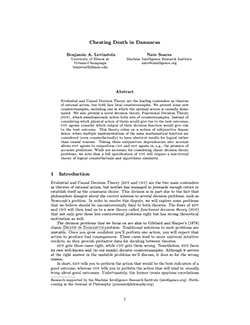 Nate Soares’ recentdecision theorypaper with Ben Levinstein, “Cheating Death in Damascus,” prompted some valuable questions and comments from an acquaintance (anonymized here). I’ve put together edited excerpts from the commenter’s email below, with Nate’s responses.
Nate Soares’ recentdecision theorypaper with Ben Levinstein, “Cheating Death in Damascus,” prompted some valuable questions and comments from an acquaintance (anonymized here). I’ve put together edited excerpts from the commenter’s email below, with Nate’s responses.
The discussion concerns functional decision theory (FDT), a newly proposed alternative to causal decision theory (CDT) and evidential decision theory (EDT). Where EDT says “choose the most auspicious action” and CDT says “choose the action that has the best effects,” FDT says “choose the output of one’s decision algorithm that has the best effects across all instances of that algorithm.”
FDT usually behaves similarly to CDT. In a one-shot prisoner’s dilemma between two agents who know they are following FDT, however, FDT parts ways with CDT and prescribes cooperation, on the grounds that each agent runs the same decision-making procedure, and that therefore each agent is effectively choosing for both agents at once.
下面,内特提供了一些自己的观点n why FDT generally achieves higher utility than CDT and EDT. Some of the stances he sketches out here are stronger than the assumptions needed to justify FDT, but should shed some light on why researchers at MIRI think FDT can help resolve a number of longstanding puzzles in the foundations of rational action.
Anonymous:This is great stuff! I’m behind on reading loads of papers and books for my research, but this came across my path and hooked me, which speaks highly of how interesting is the content and the sense that this paper is making progress.
My general take is that you are right that these kinds of problems need to be specified in more detail. However, my guess is that once you do so, game theorists would get the right answer. Perhaps that’s what FDT is: it’s an approach to clarifying ambiguous games that leads to a formalism where people like Pearl and myself can use our standard approaches to get the right answer.
I know there’s a lot of inertia in the “decision theory” language, so probably it doesn’t make sense to change. But if there were no such sunk costs, I would recommend a different framing. It’s not that people’s decision theories are wrong; it’s that they are unable to correctly formalize problems in which there are high-performance predictors. You show how to do that, using the idea of intervening on (i.e., choosing between putative outputs of) the algorithm, rather than intervening on actions. Everything else follows from a sufficiently precise and non-contradictory statement of the decision problem.
Probably the easiest move this line of work could make to ease this knee-jerk response of mine in defense of mainstream Bayesian game theory is to just be clear that CDT isnotmeant to capture mainstream Bayesian game theory. Rather, it is a model of one response to a class of problems not normally considered and for which existing approaches are ambiguous.
Nate Soares:我不接受这种观点。我的观点是莱克阀门e: When you add accurate predictors to the Rube Goldberg machine that is the universe — which can in fact be done — the future of that universe can be determined by the behavior of the algorithm being predicted. The algorithm that we put in the “thing-being-predicted” slot can do significantly better if its reasoning on the subject of which actions to output respects the universe’s downstream causal structure (which is something CDT and FDT do, but which EDT neglects), and it can do better again if its reasoning also respects the world’s global logical structure (which is done by FDT alone).
We don’t know exactly how to respect this wider class of dependencies in general yet, but we do know how to do it in many simple cases. While it agrees with modern decision theory and game theory in many simple situations, its prescriptions do seem to differ in non-trivial applications.
The main case where we can easily see that FDT is not just a better tool for formalizing game theorists’ traditional intuitions is in prisoner’s dilemmas. Game theory is pretty adamant about the fact that it’s rational to defect in a one-shot PD, whereas two FDT agents facing off in a one-shot PD will cooperate.
In particular, classical game theory employs a “common knowledge of shared rationality” assumption which, when you look closely at it, cashes out more or less as “common knowledge that all parties are using CDT and this axiom.” Game theory where common knowledge of shared rationality is defined to mean “common knowledge that all parties are using FDT andthisaxiom” gives substantially different results, such as cooperation in one-shot PDs.
Read more »
